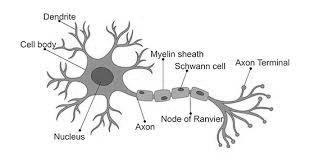
Answer
429.9k+ views
Hint: Neurons are also known as nerve cells. They send and receive signals from our brain. Whereas neurons have a lot in common with other types of cells, but they are structurally and functionally very unique.
Complete Answer:
Neuron is a specialized cell that is involved in transmitting information between electrical and chemical signals. They can be found in the brain, spinal cord and the peripheral nerves. A neuron is also called the nerve cell.
The structure of a neuron differs in their shape and size and it usually depends upon their functions and their location. Neurons are known as the structural and functional units of the nervous system. When a group of neurons come together it forms a nerve. Neurons are the structural and functional units of the nervous system. There are two types of neurons present in humans-
1. Sensory Neurons
2. Motor Neurons
The neuron is a specialized and an individual cell, which is also known as the nerve cell. A group of neurons when they come together forms a nerve.
Dendrites–A branch-like structure that functions by receiving messages from other neurons and allows the transmission of messages to the cell body.
Cell Body–Each neuron has a cell body with a nucleus, Golgi apparatus, endoplasmic reticulum, mitochondria and other components.
Axon–Axon is a tube-like structure that functions by carrying an electrical impulse from the cell body to the axon terminals for passing the impulse to another neuron.
Synapse– This structure functions by permitting the entry of a neuron to move an electrical or chemical signal from one neuron to another neuron.

Figure: Structure of a neuron
Note:
The neurons comprise the nervous system. There are two different kinds of nervous system in the body. They are the Central nervous system and Peripheral nervous system. The CNS includes the brain and spinal cord, while the PNS comprises all the associated nerves.
Complete Answer:
Neuron is a specialized cell that is involved in transmitting information between electrical and chemical signals. They can be found in the brain, spinal cord and the peripheral nerves. A neuron is also called the nerve cell.
The structure of a neuron differs in their shape and size and it usually depends upon their functions and their location. Neurons are known as the structural and functional units of the nervous system. When a group of neurons come together it forms a nerve. Neurons are the structural and functional units of the nervous system. There are two types of neurons present in humans-
1. Sensory Neurons
2. Motor Neurons
The neuron is a specialized and an individual cell, which is also known as the nerve cell. A group of neurons when they come together forms a nerve.
Dendrites–A branch-like structure that functions by receiving messages from other neurons and allows the transmission of messages to the cell body.
Cell Body–Each neuron has a cell body with a nucleus, Golgi apparatus, endoplasmic reticulum, mitochondria and other components.
Axon–Axon is a tube-like structure that functions by carrying an electrical impulse from the cell body to the axon terminals for passing the impulse to another neuron.
Synapse– This structure functions by permitting the entry of a neuron to move an electrical or chemical signal from one neuron to another neuron.

Figure: Structure of a neuron
Note:
The neurons comprise the nervous system. There are two different kinds of nervous system in the body. They are the Central nervous system and Peripheral nervous system. The CNS includes the brain and spinal cord, while the PNS comprises all the associated nerves.
Recently Updated Pages
10 Examples of Evaporation in Daily Life with Explanations

10 Examples of Diffusion in Everyday Life

1 g of dry green algae absorb 47 times 10 3 moles of class 11 chemistry CBSE

What is the meaning of celestial class 10 social science CBSE

What causes groundwater depletion How can it be re class 10 chemistry CBSE

Under which different types can the following changes class 10 physics CBSE

Trending doubts
Fill the blanks with the suitable prepositions 1 The class 9 english CBSE

Which are the Top 10 Largest Countries of the World?

How do you graph the function fx 4x class 9 maths CBSE

Differentiate between homogeneous and heterogeneous class 12 chemistry CBSE

Difference between Prokaryotic cell and Eukaryotic class 11 biology CBSE

Change the following sentences into negative and interrogative class 10 english CBSE

The Equation xxx + 2 is Satisfied when x is Equal to Class 10 Maths

Why is there a time difference of about 5 hours between class 10 social science CBSE

Give 10 examples for herbs , shrubs , climbers , creepers




